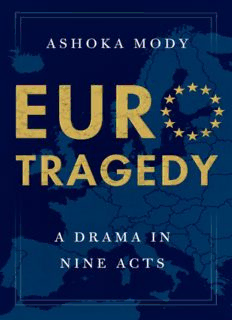
EuroTragedy: A Drama in Nine Acts PDF
Preview EuroTragedy: A Drama in Nine Acts
EuroTragedy EuroTragedy Ashoka Mody A Drama in Nine Acts 1 1 Oxford University Press is a department of the University of Oxford. It furthers the University’s objective of excellence in research, scholarship, and education by publishing worldwide. Oxford is a registered trade mark of Oxford University Press in the UK and certain other countries. Published in the United States of America by Oxford University Press 198 Madison Avenue, New York, NY 10016, United States of America. © Oxford University Press 2018 All rights reserved. No part of this publication may be reproduced, stored in a retrieval system, or transmitted, in any form or by any means, without the prior permission in writing of Oxford University Press, or as expressly permitted by law, by license, or under terms agreed with the appropriate reproduction rights organization. Inquiries concerning reproduction outside the scope of the above should be sent to the Rights Department, Oxford University Press, at the address above. You must not circulate this work in any other form and you must impose this same condition on any acquirer. Library of Congress Cataloging- in- Publication Data Names: Mody, Ashoka, author. Title: EuroTragedy : a drama in nine acts / Ashoka Mody. Other titles: Euro Tragedy Description: New York City : Oxford University Press, 2018. Identifiers: LCCN 2017046690 | ISBN 9780199351381 (hardback) | ISBN 9780199351398 (updf) | ISBN 9780199351404 (epub) Subjects: LCSH: Europe—Economic integration—History. | Europe—Economic conditions—1945– | BISAC: BUSINESS & ECONOMICS / International / Economics. | BUSINESS & ECONOMICS / Economics / Macroeconomics. Classification: LCC HC240.M694 2018 | DDC 337.1/4209—dc23 LC record available at https://lccn.loc.gov/2017046690 1 3 5 7 9 8 6 4 2 Printed by Sheridan Books, Inc., United States of America To Shalini, Who never asks for anything in return CONTENTS List of Figures ix Acknowledgments xiii List of Abbreviations xvii Introduction: Europe Ends Up Someplace Else 1 1 Three Leaps in the Dark, 1950– 1982 24 2 Kohl’s Euro, 1982– 1998 65 3 Schröder Asserts the German National Interest, 1999– 2003 124 4 Irrational Exuberance, 2004– 2007 156 5 After the Bust, the Denial, 2007– 2009 194 6 Delays and Half Measures: Greece and Ireland, 2010 232 7 Policy Wounds Leave Behind Scar Tissue, 2011– 2013 283 8 The ECB Hesitates, the Italian Fault Line Deepens, 2014– 2017 338 9 The Final Act: A Declining and Divided Europe 391 Scenarios: The Future Ain’t What It Used to Be 437 Epilogue 458 Main Characters in the Euro Drama 463 Timeline of Key Events: How It Unfolded 471 Notes 485 References 537 Index 617 LIST OF FIGURES 1.1. France falls behind Germany starting around 1870. 25 1.2. Germans led the intellectual inquiry into “flexible exchange rates.” 41 2.1. The beat of Europe’s “political union” mantra. 75 2.2. Europe’s monetary union goes against the global tide. 92 2.3. The rise of unemployment. 96 2.4. The rise of public expenditure and debt, from the Hague to the euro. 96 2.5. German and French support for Europe collapses around Maastricht. 97 2.6. Who voted “no” to Maastricht in the French referendum? 102 2.7. The depreciating lira. 118 3.1. The US Federal Reserve leads, the European Central Bank follows. 139 3.2. Earlier US recovery in stock prices and GDP. 152 4.1. Euro area: Bank assets race ahead as productivity falls. 159 4.2. “Great moderation” overcomes “irrational exuberance.” 160 4.3. Europe’s impressive postwar economic recovery. 163 4.4. Euro-area bank funding becomes riskier. 167 4.5. Euro-area banks use greater leverage to earn higher return on equity. 168 4.6. Euro-area productivity growth falls behind. 169 4.7. Trade shares of principal euro-area countries with their euro-area partners fall or stay flat. 171 4.8. As interest rates fall, countries in the euro-area periphery become more indebted. 173
Description: